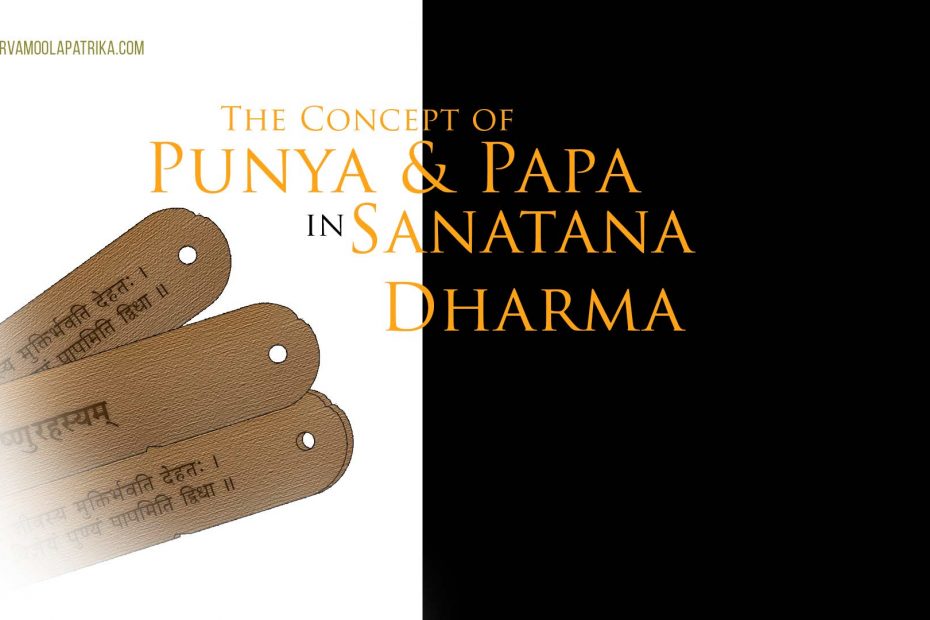The concepts of puNya and pApa is a very important foundational principle in sanatana dharma. Our shAstras consider it vitally important that people believe in puNya and pApa so dharma sustains in this world. It is impossible for the world to function only through the iron hand of the law. If the world has to survive, majority of its people must do good and avoid bad due to their inherent beliefs rather than being forced to do so by external agencies. Hence paramAtma has created the concept of puNya and pApa and associated benefits and demerits with them.
Although the terms puNya and pApa are quite well known, most people do not delve into them beyond a cursory understanding. Such a situation is always dangerous because it takes only a little bit of churning of the mind to dislodge one from a dharmika belief system. Unfortunately, while many of our shAstra granthas use the terms puNya and pApa liberally, not many go into the depths of what they are. Needless to say, in popular literature, there is even less material available about these concepts.
shrImadAnandatIrtha bhagavatpAda has also explained many intricacies of shAstras in his works on the basis of puNya and pApa. In his mahAbhArata tAtparya nirnaya for e.g. the fate of many characters such as vAli, balarAma, kamsa and others have been explained by him on the basis of puNya and pApa. This shows us the importance of obtaining a better understanding of this concept in our adhyAtmic journey.
Vishnu rahasya, one of the important compositions of shrI bAdarAyaNa, talks about karma siddhAnta, puNya and pApa in great detail. This grantha has also been quoted multiple times by shrI madhwAchArya. Hence it is a valid pramANa grantha for us. Let us try to understand these concepts a little better by referring to the 11th chapter of vishnu rahasya.
Karma, puNya and pApa
The entire concept of karma, puNya and pApa has been elucidated by shrI bAdarAyaNa when he reveals the conversation between brahma and his creator vishnu. Brahma requests his father to help him understand these terms. Vishnu starts by defining what these are.
येन बद्धो नरो मुक्तिं न व्रजत्येष संसृतौ |
स्वर्गे वा नरके वापि भ्रमत्येवानिशं यतः ||
यस्य क्षयेण जीवस्य मुक्तिर्भवति देहतः |
तद्धि कर्मेति विज्ञेयं पुण्यं पापमिति द्विधा ||
“That, which binds a jIva and prevents him from obtaining mOksha, and due to the result of which he wanders between swarga and naraka; That, due to the destruction of which, one gets liberated from the bondage of samsAra, is known as karma. PuNya and pApa are the two varieties of karma”
Definition of puNya and pApa
That which leads to sukha (happiness) is puNya. That karma which leads to dukha (sorrow) is pApa. Here sukha means obtaining (of that good) which one desires. Conversely, obtaining something that is not desirable is dukha.
puNya can be obtained by performing those activities which have been mandated as kartavya or duty in the shrutis, smriti, purAnas and other sadAgamas. Another way of earning puNya is by giving up that which is essential for us, such as sleep, food or procreation (for a greater good), or by giving up those comforts that the shAstras declare as undesirable.
pApa is accumulated by performing those karmas which the shrutis, smritis and other shAstras declare as wrong. pApa is also earned by giving up those karmas which have been mandated as compulsory in the shAstras.

Pingback: The Concept of Punya and Papa in Sanatana Dharma – II/III – Sarvamoolapatrika
Pingback: The concept of Papa and Punya in Sanatana Dharma 3/3 – Sarvamoolapatrika
Good article